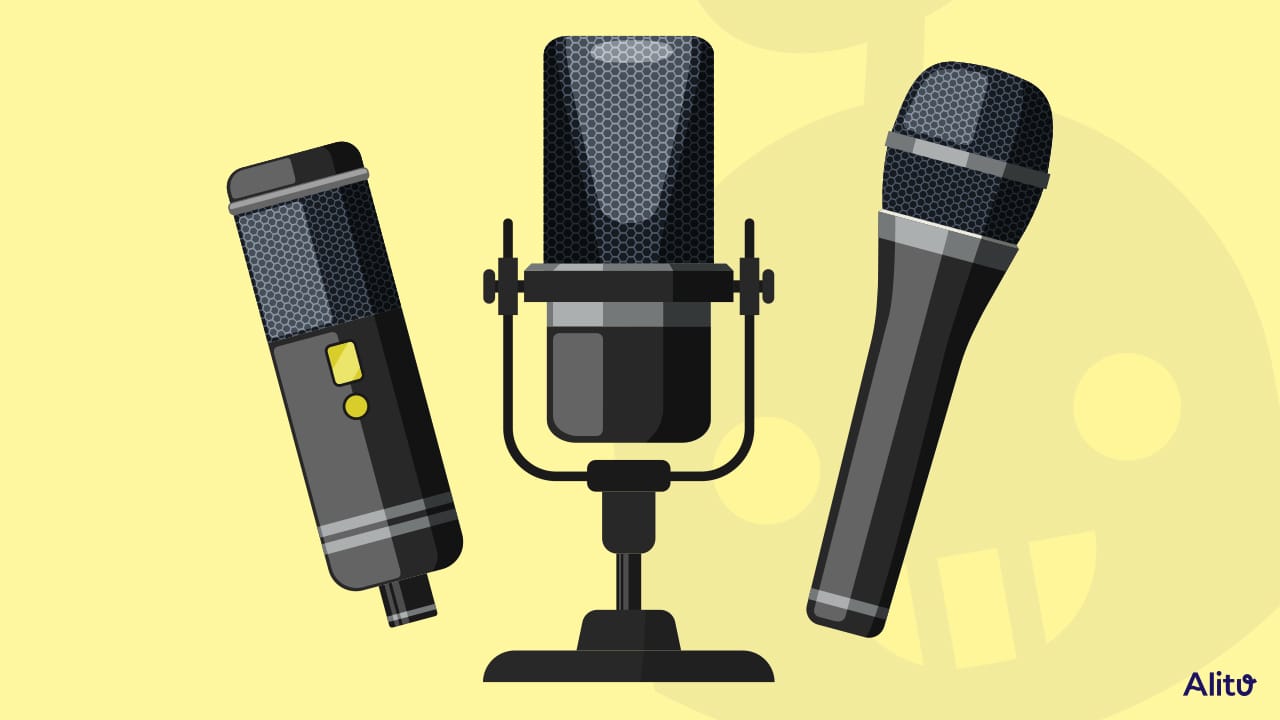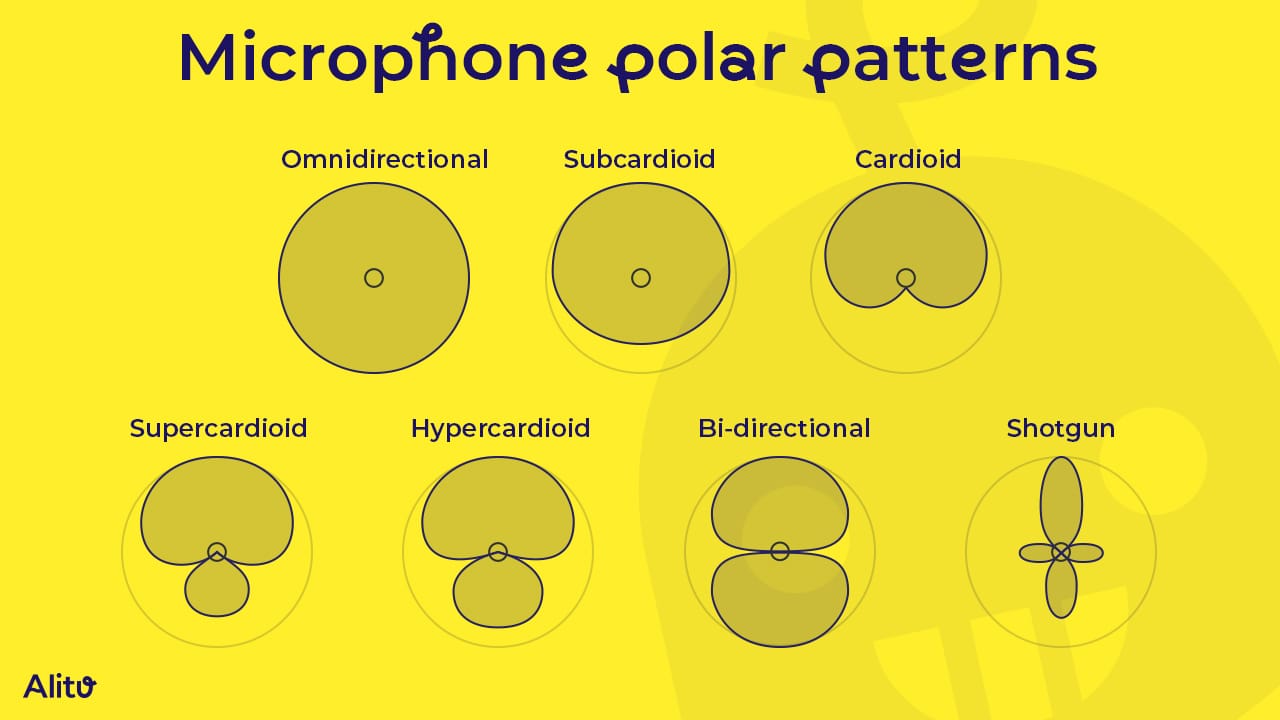Best Podcast Microphones (From 15 Years of Testing)
Choosing a podcast mic can be overwhelming. With so many options out there, how do you find the one that actually fits your setup, style, and budget?

Over the past 15 years, I’ve tested dozens of podcast mics. Maybe even close to a hundred. I’ve tried the classics, the flops, and a few hidden gems along the way.
But I’m not here to name-drop every single mic I've used for the sake of variety or SEO. This best podcast microphones roundup focuses on the ones that are genuinely worth your consideration, depending on your setup, style, and budget.
I’ve organised this roundup by use case, with a clear recommendation for each one. Some models show up more than once. That’s not a mistake or filler. It’s because they genuinely work across different setups.
Quick heads up: this post contains affiliate links, which help support our free content. If you choose to buy through them, we may earn a small commission - at no extra cost to you!
Let’s dive in.
Best Overall Podcast Microphone: Samson Q2U
Also wins: Best for Beginners • Best Budget Mic Under $100
The Samson Q2U is one of the most popular mics in podcasting, second only to the Blue Yeti. In my view, it should be the first. Granted, you’ll find many technically superior microphones to the Q2U, but it wins the day because of the quality and versatility it offers at its low price point. The Samson Q2U is perfect for almost all new podcasters, and to this day, I still use mine every single week.
Essentials
- USB & XLR
- Dynamic
- $80
Pros
- Superb value for money.
- Start with USB, option to upgrade your setup later without changing your mic.
- Works well in imperfect rooms.
- Does a better job than most at keeping handling noise in check.
- Often available in "podcasting bundle" deals.
Cons
- Holds its own with vocal quality, but better is available elsewhere.
- Isn’t visually appealing to many video podcasters.
- USB-A connection means you might need an adapter if you're running a newer laptop.
Samson Q2U Alternatives
The ATR2100x is an almost identical mic in terms of look and build. It can be a little more expensive, though still tremendous value. With 24-bit audio (versus the Q2U's 16-bit), it has a better dynamic range for recording both louder and quieter sounds. It also has a more modern USB-C connection as opposed to the Q2U's traditional USB-A.
Best USB Microphone for Podcasting: AKG Lyra
There are a few contenders for this spot, and yes, the trusty Q2U deserves a mention. But I’m going with the AKG Lyra because it was the first USB mic I tested that sounded like a higher-end XLR mic. It’s as if AKG looked at the Blue Yeti and asked, “What if we actually made it good?” The Lyra has a clean, slightly retro design and comes with its own stand, though you can also mount it on a boom arm. It often sells for under $100, making it a solid choice for budget-conscious creators who still want great sound without additional XLR kit.
Essentials
- USB
- Condenser
- $90
Pros
- Great sound for USB-only, and at a low cost.
Cons
- Unforgiving in less-than-ideal environments, will pick up background noise and reverb.
- Slightly harsh to call this a Con, but multiple polar patterns suggest the mic can be used for anything other than solo use. It shouldn't!
Best USB Mic Alternatives
The Rode Podcaster is another popular USB mic in podcasting with a good level of sound quality. Our founder, Colin, still uses his regularly!
Best XLR Microphone for Podcasting: AT2020
Also wins: Best Condenser Mic
There are so many brilliant mics to choose from in this category. Many cost upwards of $300, some even venture into the four figures. I’m going to pick out the Audio-Technica 2020 because, as you can probably tell by now, I like getting the maximum value for the minimum spend. The AT2020 goes toe-to-toe with mics double or triple its price, and it’s hard not to like that about it!
Essentials
- XLR (USB version is available)
- Condenser
- $100
Pros
- Bundle deals often available.
- For a condenser mic, it performs admirably in untreated rooms.
Cons
- XLR mics can't plug directly into your computer; you'll need a mixer, audio interface, or digital recorder to run them.
Best XLR Mic Alternatives
- The MXL990 is a classic old condenser; we had one in our studio for years, and it'll give you great vocals for only about $60. It's a bit fragile, though. Ours died when the studio got too cold one winter!
- The Shure SM58 is another classic, but traditionally in the world of live music. This famous old workhorse is an almost indestructible dynamic mic that'll hold up in any situation.
- The Rode Procaster is the XLR alternative to the Rode Podcaster. I like it, though I do feel it's a little expensive compared to what's available elsewhere.
Best Dynamic Microphone for Podcasting: Shure MV7+
The Shure MV7 was the third most popular podcast mic in our 2024 podcast gear survey. The MV7+ is its more recent iteration, and builds on what was already a fantastic microphone. This mic works in both USB and XLR form, though it puts in a stronger showing as the latter.
MV7+ owners have access to additional features inside Shure's MOTIV Mix software, including a 'Popper Stopper' for plosive protection and tone variation, which can add 'dark' and bright' presets to your voice.
Essentials
- USB & XLR
- Dynamic
- $300
Pros
- It isn't a million miles away from the classic Shure SM7b, but a fair bit cheaper.
Cons
- It's still an expensive mic in its own right.
- Its USB function didn't perform as well as the XLR in testing.
Best Dynamic Mic Alternatives
The Samson Q9U (no, not the Q2U!) is another quality USB/XLR dynamic mic option available for only about $125.
Best Studio Microphone for Podcasting: Rode NT1 5th Gen
Not only is the Rode NT1 5th Gen “the world’s quietest mic”, it also boasts 32-bit floating technology that makes it “unclippable” when used in its USB form. If I had a permanent, fully sound-treated studio setup, I’d have a couple of these set up and ready to roll at all times.
Essentials
- USB & XLR
- Dynamic
- $250
Pros
- Ultra-low noisefloor.
- 32-bit floating "unclippable" setting when used as USB mic.
Cons
- Expensive.
- Doesn't sound good in suboptimal environments.
- 32-bit floating unavailable when used in XLR form.
Best Studio Mic Alternatives
There's a bounty of notable and quality options if you have the budget to kit out a pro-level podcast studio.
- The SM7b is an iconic mic, known by many as "the one Joe Rogan uses".
- The SM7db is essentially a reworking of the above, with a built-in preamp.
- The Lewitt RAY is a novel condenser mic with a laser that keeps you "on mic" even if you move further away from it.
- The Electro-Voice RE20 is an incredible dynamic mic, though at an incredibly hard-to-afford price.
- The Heil PR40 is traditionally regarded as the Holy Grail of podcasting mics. Some love it, while others say it's over-hyped and overpriced. I think it's decent and certainly worth a nod, but I wouldn't pay more than $300 for it.
Best Microphone for Video Podcasting, Camera, & YouTube: Rode Wireless Pro
Also wins: Best Wireless Microphones & Mic Systems for Podcasting
Rode has steadily refined its wireless mic lineup, and the Wireless Pro is its best yet. The kit includes two transmitters (clip-on mics) with onboard recording and a receiver that connects to your phone, DSLR, or computer. You also get two Rode Lavalier II mics, which, to buy individually, cost about $80.
The Wireless Pro has a rock-solid range of up to 260 metres, which is a hell of a distance to put between yourself and your co-host. If you're a YouTuber constantly repositioning your boom arm or worried about looking like you're eating the mic, this setup could be exactly what you need.
Essentials
- Computer, phone, or camera use
- $350
Pros
- Portable and versatile
- Superb sound
- On-board transmitter recording
- Huge wireless range
Cons
- Though great value for money, $350 is a big outlay.
Best Video Mic Alternatives
The Shure MoveMic is Shure's premium option in this category, and another one that social media "influencers" bizarrely choose to hold in their hands rather than clip on to their jumpers.
Best Portable Clip-On Microphone for On-the-Go Podcasting, Interviews & Smartphone Use: Rode Wireless Micro
If the Rode Wireless Pro feels overkill or over budget, then the Rode Wireless Micro is a perfect substitute. It’s less than half the price, but similar in many ways. There are versions for both Apple (Lightning) and Android (USB-C) devices. The Wireless Micro has been my go-to interview kit now since the turn of the year, and I’m always amazed that the audio I capture was recorded on a phone.
Essentials
- iPhone or Android
- $150
Pros
- Brilliant two-person smartphone audio.
Cons
- You need to choose Lightning OR USB-C, so if you change devices, it may no longer be compatible.
Best Clip-On Mic Alternatives
At the time of writing, you can pick up the BOYA Mini for only $30. Fair enough, it doesn't rival the Rode Wireless Micro, but I don't think there's $120 of difference.
Best Headset Mic: The Antlion Modmic 2 USB
Headset mics are still popular amongst podcasters, but they’ve always struggled with comfort and thin, tinny sound. The Antlion ModMic 2 USB fixes both. It attaches to your favourite over-ear headphones, turning them into a high-quality headset mic. The boom arm snaps on with a small magnet and detaches easily when you just want to listen.
It's worth mentioning that a similar kit, the ModMic Uni 2, is also available. Instead of a USB connection, it has a 3.5mm plug, allowing you to run it into most digital recorders or audio interfaces.
Essentials
- USB (3.5mm model available)
- $100
Pros
- Use your existing comfy headphones.
Cons
- No use if you don't have any existing comfy headphones.
- No active monitoring on USB model - you can't hear your voice being played back as you record.
Best Headset Mic Alternatives
You know who loves headset mics? Gamers. And I imagine that if your audio isn't decent in that cut-throat world, you'll get pwned for being a n00b. With that in mind, the Razer Barracuda X offers a good balance of comfort and sound quality.
Best Multi-Use USB Microphone: Rode NT1-USB Mini
“How can I plug in multiple USB mics at the same time?” has been a largely unsolved problem for podcasters over the years. There have always been hacks and workarounds, but few of them are straightforward or optimal. Rode changed that with the Rode NT1-USB Mini and their companion “Connect” software, enabling you and four pals to record on separate USB microphones into the same computer.
Essentials
- USB
- Condenser
- $100
Pros
- Use multiple USB mics simultaneously.
Cons
- Only works with supported Rode microphones.
Best Multi-Use USB Mic Alternatives
Rode Connect can also run the Wireless GO II, VideoMic NTG and the VideoMic GO II in the same manner.
Best Microphone for Echoey Rooms & Bad Acoustics: PreSonus Revelator Dynamic
I flip-flopped over deciding on this one. Our old friend, the Samson Q2U, performs well in this category, as do the Shure MV7+ and Shure SM58. However, I reckon I’ll opt for the PreSonus Revelator Dynamic. The mic’s off-axis rejection means that it holds up well in suboptimal conditions. That isn’t to say you should ignore all attempts to treat your space, but the Revelator will help minimise reverb's impact in a pinch.
In my sound sample, I mentioned that I wasn’t keen on the presets in the companion software, but I wouldn’t worry too much about that. I’m not a fan of adding effects during recording, and I’m judging this mic purely on how it handles raw vocals
Essentials
- USB
- Dynamic
- $90
Pros
- Resistant to suboptimal environments.
Cons
- Noticeable noisefloor (hiss) in recordings, though this is typical of 'hungrier' dynamic mics.
Best Suboptimal Room Mic Alternatives
- The Shure MV7+ is marketed as offering “perfect recordings for imperfect rooms.”
- The Samson Q2U - surprise, surprise!
- The Shure SM58 isn't phased by terrible rooms, either. Honestly, it isn't phased by anything.
Most Popular Podcast Microphone: Blue Yeti
The Blue Yeti shows up in over 16% of podcast setups, according to The Podcast Host's 2024 gear report. But many users also reported replacing it, which suggests it did not live up to expectations. When set to Cardioid and used up close as a solo mic, the Yeti can deliver decent results. The problem is that it is easy to misuse. If you already own one, the above video will help you get the best out of it. But if you are shopping for a new mic, there are better-sounding and more forgiving options for less.
Essentials
- USB
- Condenser
- $100
Pros
- Easy to find.
- Looks nice.
- Alright, it's still better than the Blue Snowball 😂
Cons
- Easy to misuse.
- Much better mics are available for less.
Blue Yeti Alternatives
As the Blue Yeti is typically a beginner's first podcast mic, we come full circle to the Samson Q2U. Save yourself some money, simplify your setup, improve your audio, and if you choose to upgrade your gear later on, you won't need to replace it!
Podcast Mics FAQ
I’ve offered recommendations for every situation and use case, but you may still have a few unanswered questions about podcast microphones. Chances are, it’s one of these three...
Condenser Vs Dynamic Mics
These terms tell you about how mics are built and how they function.
To simplify it, dynamic mics tend to be tougher workhorses; you might lose a little detail or finesse, but they're much more forgiving.
Condenser mics, on the other hand, can give you better vocal recordings, so long as everything else in your setup and environment is on point.
Condenser mics are also typically more breakable, and they need Phantom Power to operate. Phantom Power is a setting you'll find on almost any digital recorder, mixer, or audio interface.
USB Vs XLR Mics
Some mics plug directly into your computer via USB cables. These are also known as digital mics.
XLR mics are more traditional and sometimes referred to as "analogue". You can still run an XLR mic into your computer, but you'll need an additional bit of kit like a digital recorder, mixer, or audio interface to act as the go-between.
What Are Microphone Polar Patterns?
Polar patterns, also known as pickup patterns, dictate the areas around any mic that it will focus on and "hear". Almost all vocal mics have a Cardioid polar pattern, meaning they're designed for one person to record into.

Another common polar pattern is Omnidirectional. This setting means there's no bias towards any one area around the mic; it just listens to "everything" equally. You'll find this polar pattern on most lavalier microphones.
Be wary of mics that boast of multiple polar patterns, promising various ways you can share them with one or more people. These setups never sound good. They're the reason so many people think the Blue Yeti sounds awful.
Summary: So What IS the Best Podcast Microphone?
I hope this whirlwind tour of my top podcast mic recommendations has been useful. Here are the essential takeaways:
- If you're a beginner with a small budget and only an "ordinary" room to podcast in, then opt for the Samson Q2U or ATR2100x.
- If you plan to record on the go or do video with your phone, opt for the Rode Wireless Micro or BOYA Mini kit.
- And, if you've been podcasting with a USB mic and are looking to upgrade to something a bit more pro-level, consider the Rode NT1 5th Gen, the Audio-Technica 2020, or the SM7db!

